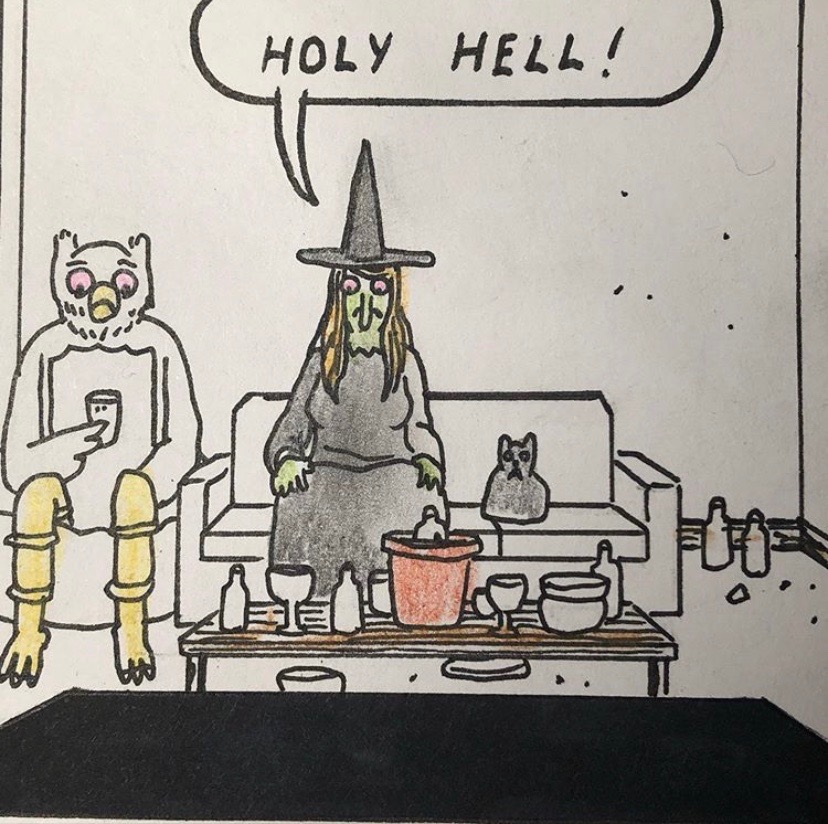
On March 13, 2020, the bells of Covid-19 lock-down chimed loudly with an Instagram post by Simon Hanselmann that begins “Holy Hell!”. Reality and the quasi-fantastic reality of the Megg and Mogg universe became, at that moment, intertwined and Crisis Zone began collapsing these two streams of time into a daily comic cataloging the adventures of Megg, Mogg, Owl, Werewolf Jones, and the rest of Simon Hanselmann’s trademark characters as they navigate the challenges and absurdities of the present moment. From the BLM protests, Seattle’s Autonomous Zone, Tiger King, the release of Animal Crossing: New Horizons, and the Coronavirus pandemic, Crisis Zone engages with this material with a balance of humor, relatability, and nausea all-the-while featuring subtle cartooning innovations that marry the form of Instagram “comix” with high-quality conventional cartooning.
Readers of the previous Megg and Mogg comics will be well acquainted with the prominent characters of Crisis Zone, but there are many key formal and thematic differences that separate it from the previous installments in the series. Interestingly enough, this is one of the longest cohesive Megg and Mogg stories produced, flowing continuously rather than broken up into smaller vignettes that constitute a book like Bad Gateway or Megahex. And this departure from the vignette works to great effect for the thematics of a work that is simulating the constant flow of bad information we all are privately consuming through news outlets in capital R “Reality”. Rather than moments of life that become overstated and highlighted due to their requisite effect on the characters experiencing it, we watch the large-scale collapse of society along with the reactions of these characters that we have grown to love. While the hostility of society has been frequently displayed in previous Megg and Mogg projects, it is the focus of Crisis Zone. Megg is catatonic for most of Crisis Zone, Mogg spends a large amount of time away from the core-cast only to be imprisoned on his return, Owl has slowly descended into nihilism after an attempt at monetizing Werewolf Jones’s body on OnlyFans and, subsequently, Netflix has given him a reality show focusing on Werewolf Jones’s tyrannical leadership over the gang.
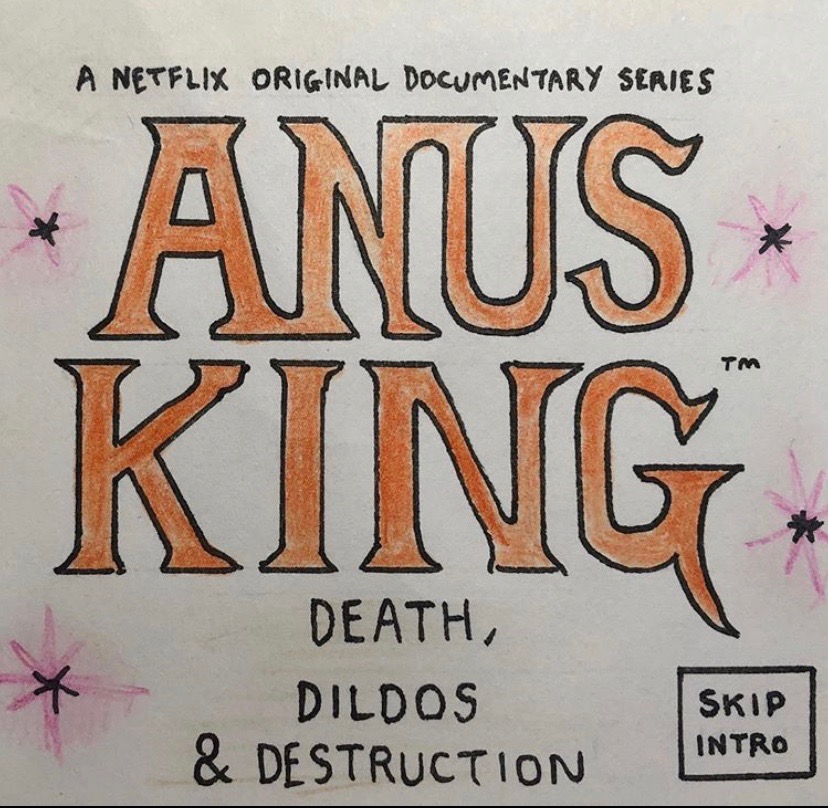
In terms of tone, watching these characters navigate the mental distress of the moment creates an elaborate panic that vacillates between utter chaos and quiet surrender to the local circumstances. It is somewhat less relatable than episodes from the previous books that prominently feature struggles with mental health, drug abuse, and alienation, but the stretching of these limits of relatability is similarly enthralling to observe as Hanselmann experiments with cataloging separate reactions to the state of the world and how we attempt to institute control in light of our powerlessness against factors like a contagion, economic collapse, and mass social upheaval. We are, as well, dealing with distortions in our own personal definitions of “crisis” and what constitutes panic, clamoring for control in our local circumstances hopefully in healthier ways than those seen in the comic.
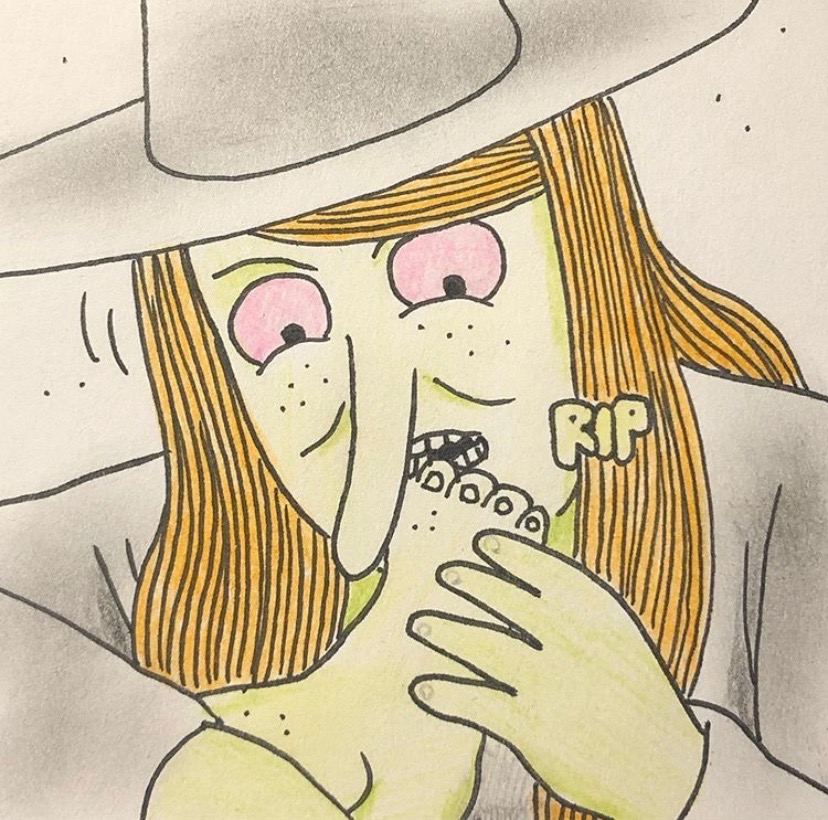
The most glaring and, potentially most interesting, difference is the implementation of the Instagram one-panel swipe format that estranges the reader from the “full-page look” and, incidentally, the dissolution of the “layout” as a load-bearing fixture of the comics medium. This gels well with Hanselmann’s cartooning, as the book-size Megg and Mogg efforts have always emphasized a comedic timing that relied on equal-size paneling. The grid, either in divisions of 6, 12, or 24, has always been a key fixture in Megg and Mogg, providing beats that can cause the reader to either linger or proceed swiftly depending on the verbal or visual content of each panel. It’s a great format for jokes and pacing because it offers the sensation of having even the most intense moments carry, in terms of page real estate, the same amount of weight as the most trivial moments. The importation of this style to Instagram works to great effect because of the implicit weight placed on an individual image. As a post occurring on a feed populated with other singular images, Crisis Zone stands, at first glance, on the power of each individual panel that constitutes the whole of the comic. And each panel is quite good. Either in an instance of high-comedy like Werewolf Jones completely naked fist-fighting with Chris Hansen, or, in a moment of private surrender, Owl sighing and saying “Fuck” on the couch, every panel feels like a punchline.
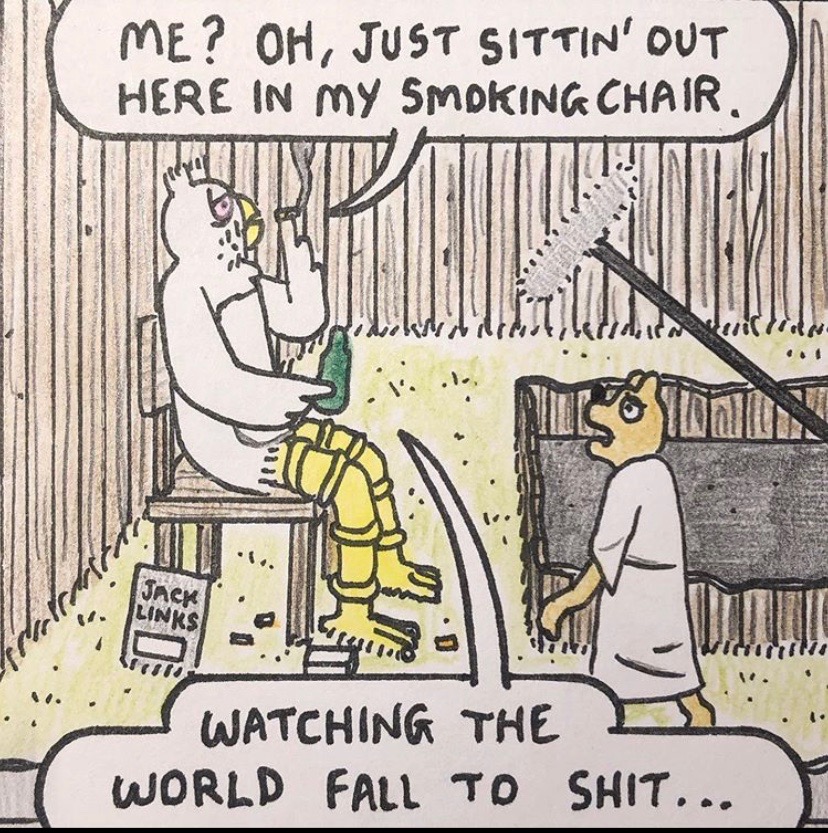
Crisis Zone exists on your phone and, therefore, is mired in the landscape it’s responding to. It is not a book. It might never be a book. There is quite literally nothing physically distancing the reader from looking into a stream of news reports and information displaying an ever-worsening condition of the world. And Crisis Zone is a fictitious, simplified version of that experience. Furthermore, you can share it with everyone who follows you on Instagram. You can propagate the information sphere with this substitute for reality, and further the engagement with this piece of media. Obviously, there are similarities with something produced in book-format. We can read reviews, or share pictures of our books. We can share the author’s Instagram page to boost their visibility, or engage in discussion about the book’s content. To consume Crisis Zone, however, is the same action as to consume non-fictional media. So, at its core, Crisis Zone is a distortion of reality that exists alongside our mode of consuming non-fictional reality in this time where it is quite literally perilous to leave your home. Even as an engagement with escapist-media, reading Crisis Zone is not a realm to escape to, as much as it is a parallel reality that throws the fears and concerns of the average individual back at them, albeit humorously, absurdly, and with a Dildo Cult as well as a Thong Funeral.
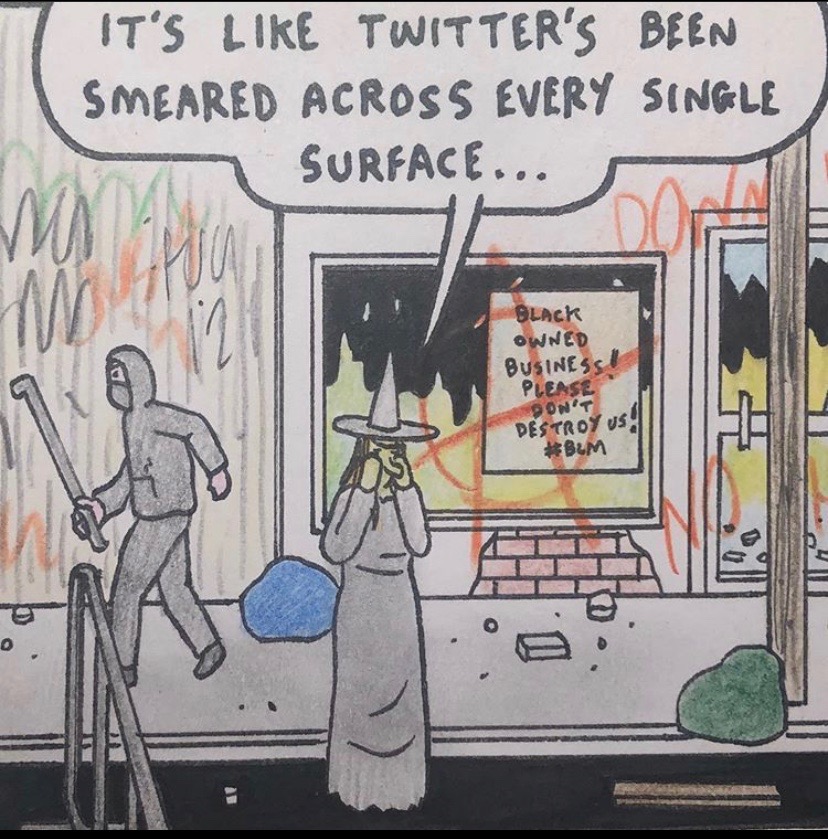
The recognition of these fundamental differences between Hanselmann’s book-length projects and this daily format are important insofar as they construct Crisis Zone as a work that is both formally and thematically engaged with our social reality. The comic is fundamentally reactionary. It indulges completely in the fact that Social Media and the pace of information consumption we have grown accustomed to provides an endless stream of material to be repurposed in a fictional narrative. This information and the pace of this information are terrifying, and the characters of the comic feel this collective terror as they also respond to these events. The characters mimic talking points or phrases that the reader is most likely familiar with: The J.K. Rowling Transphobia scandal, Cancel Culture, and Amazon workers peeing in bottles in fulfillment centers have all been referenced. As Megg says in one of the installments set in the Autonomous Zone: “My God it’s just politics and activism everywhere, It’s like Twitter’s been smeared across every single surface”. This particular quote somewhat sums up both the things that make Crisis Zone captivating and also what makes it occasionally nauseating. For all of its ability to make the reader observe the large scope of reactions that many individual people have toward the pandemic and the undeniable state of crisis we are all in, there is a propensity for the comic to become nauseatingly contemporary. In this state of endless reaction, along with the impulse to commentate, the comic has moments of seeming disgust with its own endlessness. But the show goes on and it becomes more chaotic and more unreal every day.
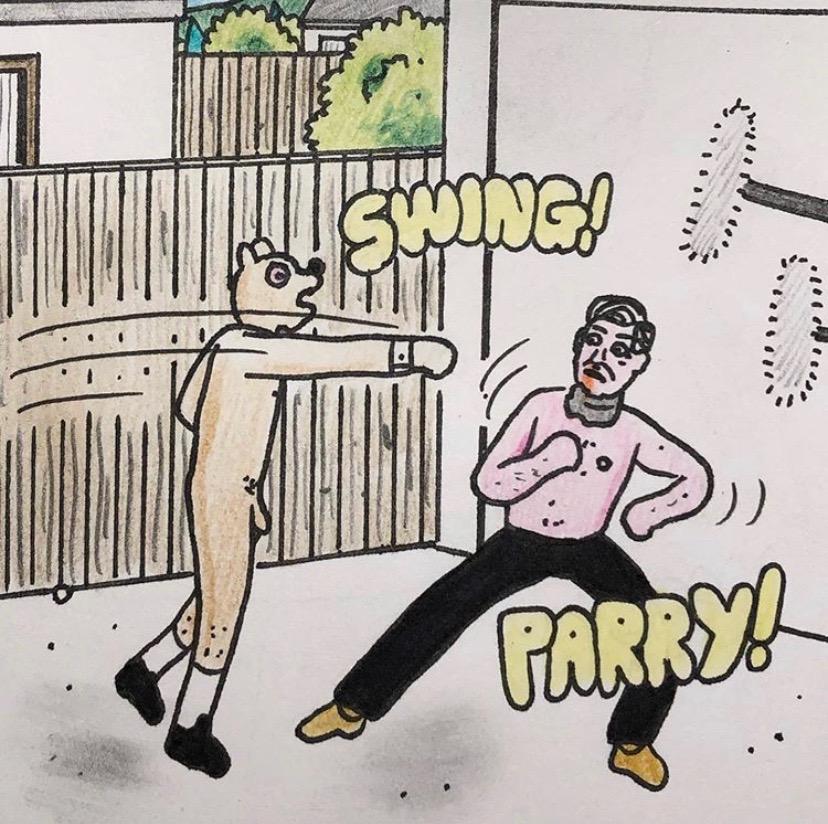
Ultimately what makes up Crisis Zone, from the socially apropo format of its publication, the clear style of the cartooning, the well-balanced tonal shifts, and the exhaustion all of this induces, is a fictional matrix of engagement. It is, either unintentionally or intentionally, perfectly captivating to engage with and to be engaged with. And there’s really no end in sight. As of the time of this writing, there have been (March 13, 2020 – October 8, 2020) 194 Crisis Zone installments (I counted each one to arrive at this number). They aren’t numbered. Ostensibly they will continue until this “crisis” ends, but, to that end, it’s important to ask: what does the end of this look like? Is there a shocking rising action that culminates dramatically in a large-scale climax followed by an epilogue? Does it just end, punctuated, without anything more to say or anything to respond to? Or is this reality now? Does life just continue into a state of integration where the pace of life constantly bombarded by ever-worsening news actually just becomes normal? And is that comforting? I don’t think so. I find Crisis Zone hilarious, but it is undeniably dizzying to deal with.
SOLRAD is made possible by the generous donations of readers like you. Support our Patreon campaign, or make a tax-deductible donation to our publisher, Fieldmouse Press, today.

Leave a Reply